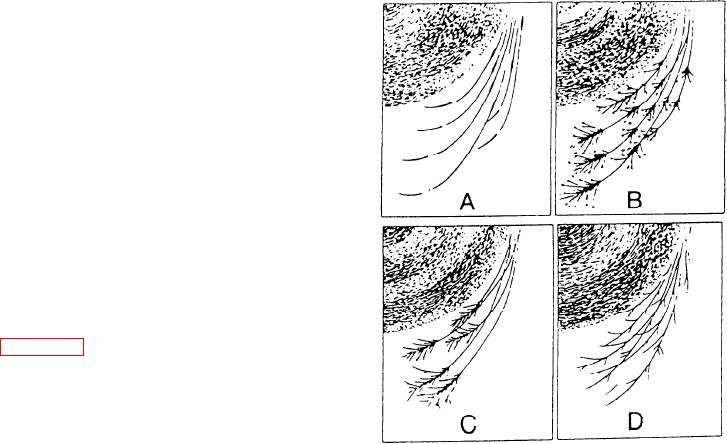
indicate a high carbon content. View C shows shafts,
with that of known specimens. Many shops maintain
forks, and sprigs that indicate a medium carbon
specimens of known composition for this purpose.
content. View D shows shafts and forks that indicate
Proper lighting conditions are essential for good
a low carbon content.
spark testing. You should perform the test in an area
where there is enough light, but no harsh or glaring
The greater the amount of carbon in a steel, the
light. You may find that many ships have a spark test
greater the intensity of bursting in the spark stream.
cabinet. Generally, these cabinets consist of a box
To understand the cause of the bursts, remember that
with a dark, painted interior, mounted on top of a
while the spark is glowing, the carbon in the particle
workbench. A bench grinder is mounted inside the
contacts oxygen in the air and is burned to carbon
cabinet. Test specimens of known composition are
dioxide (CO2). The CO2 in the gaseous state
stored in shelves at the end of the cabinet. Where
increases in volume and builds up pressure that is
relieved by explosions of the particles. If you
possible, the testing area should be away from heavy
drafts of air. Drafts can change the tail of the spark
examine the small steel particles under a microscope
stream and may result in improper identification.
when they are cold, you'll see they are hollow spheres
Generally speaking, a suitable grinding wheel for
with one end completely blown away.
spark testing is an 8-inch wheel of 30 to 60 grains
Steels with the same carbon content but different
turning at 3,600 rpm. This provides a surface speed
alloying elements are not always easily identified
of 7,537 feet per minute.
because alloying elements affect the carrier lines, the
bursts, or the forms of characteristic bursts in the
The speed of the grinding wheel and the pressure
spark picture. The effect of the alloying element may
you exert on the samples greatly affect the spark test.
retard or accelerate the carbon spark or make the
The faster the speed of the wheel, the larger and
carrier line lighter or darker in color. Molybdenum,
longer the spark stream. The pressure of the piece
for example, appears as a detached, orange-colored,
against the wheel has a similar effect: the more
spearhead on the end of the carrier line. Nickel seems
pressure you apply to the test piece, the larger and
to suppress the effect of the carbon burst. But, the
longer the spark stream. Hold the test piece lightly
but firmly against the wheel with just enough pressure
to prevent the piece from bouncing. Remember, you
must apply the same amount of pressure to the test
specimen as to the sample you are testing.
Be sure to keep the wheel clean at all times. A
wheel loaded with particles of metal will give off a
spark stream of the type of metal in the wheel mixed
with the spark stream of the metal being tested. This
can confuse you and prevent you from properly
identifying the metal. Dress the wheel before you
begin spark testing and before each new test of a
different metal.
To do a spark test, hold a sample of the material
against a grinding wheel. The sparks given off, or the
lack of sparks, help you identify the metal. Look for
the length of the spark stream, its color, and the type
of sparks.
Figure 3-2 shows the four fundamental spark
forms. View A shows shafts, buds, breaks, and
arrows. The arrow or spearhead is characteristic of
molybdenum, a metallic element of the chromium
group that resembles iron and is used to form
steel-like alloys with carbon. The swelling, or buds,
in the spark line indicate nickel with molybdenum.
Figure 3-2.--Fundamental spark forms.
View B shows shafts and sprigs, or sparklers, that
3-12

